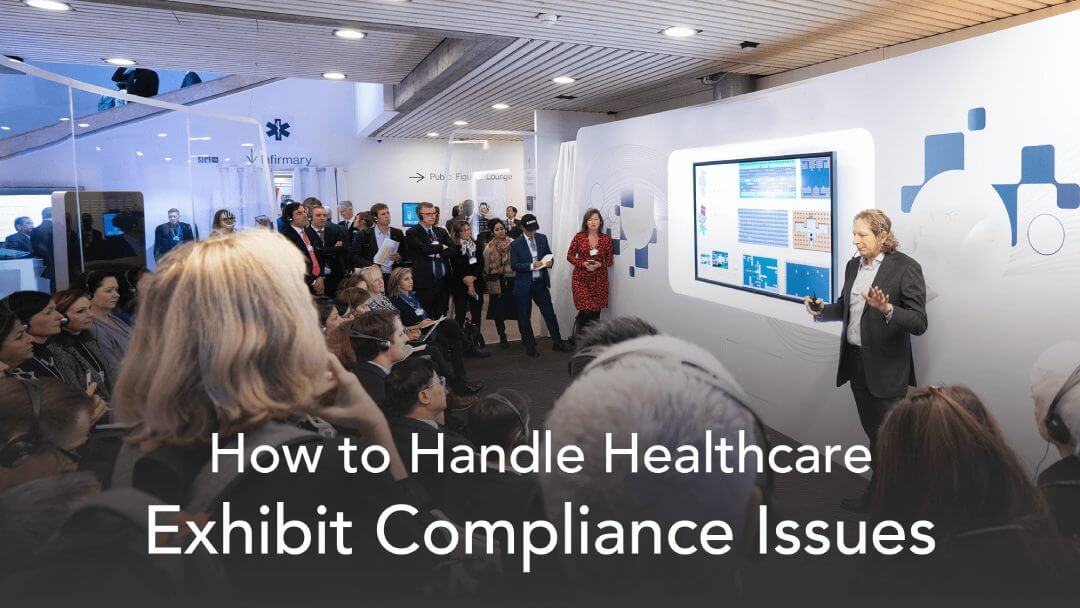Exhibit compliance issues can be a minefield in healthcare, or at least that’s the existing perception, especially among those who work outside healthcare. Understanding the actual exhibit compliance issues within the actual congress environment isn’t too much of an intellectual challenge, but sometimes the media, generalists in the face-to-face area, or marketing pundits who shy away from healthcare because of the fear of running into exhibit compliance issues perpetuate the misconception that compliance is one series of roadblocks after another when good ideas are on the table.
The reality of the situation is simple and relatively easy to explain. First, let’s dispel the myth that there are unmanageable numbers of “rules” to be followed.
Exhibit Compliance and Face-to-Face Marketing
What gets overlooked in most of the misinformation mentioned about exhibit compliance issues is that major pharmaceutical companies have internal legal and regulatory officers whose role it is to interpret various guidances and state laws before there is any implementation of promotional initiatives, including exhibits. That means that anything developed by agencies and exhibit houses is subject to this scrutiny before use.
Since the consequences for any violations can be severe or at least costly, these internal bodies tend to be conservative in rendering opinions. Among the implications for the internal exhibit staff and its partners is that timelines are sometimes blown to bits. And herein lies the real challenge.
What do regulatory and compliance officers need to consider before giving the green light to promotional initiatives? Here is their framework:
The FDA
The FDA has said much less about exhibit compliance issues than many in the industry believe. A simple example: the FDA, in the 1980s, said there should be a separation between promotional and medical activities. That’s all. There was no suggestion that a wall of mums should separate two sections of the exhibit.
The FDA regulates the safety and effectiveness of drugs, and FDA judges whether a product’s benefits to users will outweigh its risks. The FDA’s Office of Prescription Drug Promotion (OPDP) is responsible for regulating the advertising and promotion of drugs and is responsible for enforcing actions and compliance.
Via the Office of Prescription Drug Promotion (OPDP), the FDA regulates anything disseminated by or on behalf of a company that can be considered promotional including
- Spoken Word
- Advertisements
- Graphics
- Promotional Materials
- Social media and web sites
Anything that states or implicitly suggests an unapproved claim for a product is subject to a Notice of Violation (NOV).
The FDA, more than anything else, is concerned about the quality and accuracy of promotional communication. This includes ensuring that marketers only make product claims as stated on the approved product label and that marketers present adequate fair balance, as in the presentation of risk information.
Sunshine Act/Open Payments
The most recent addition to the canon of what is allowable at conventions is the Sunshine Act/Open Payments, federal legislation that comes with penalties for non-compliance. Details are here. This legislation doesn’t ban payments, gifts, or transfers, but mandates reporting of individual payments, gifts, or transfers/gifts that are individually over $100 or that cumulatively total $100 or more for the year. If you follow this process and there is a possibility that you might have reason to give something to the same doctor at more than one convention or in other situations, you don’t have to report them. Reporting is a good idea to learn when or whether the value hits $100.
For example, companies can offer healthcare professionals (HCPs) educational gifts if those items do not possess “substantial value,” which, again, it defines as $100 or more. Exhibitors can offer educational items such as textbooks, medical journals, and even anatomical models. While those items could be digital, and thus viewed on a tablet, HCPs could not be offered a tablet itself.
According to the Act, Knowingly failing to submit payment information will result in a civil money penalty of not less than $10,000, but not more than $100,000, for each payment. The penalty will not exceed $1,000,000. Combined, penalties may not exceed $1,150,000. However, fines or penalties at these levels seem to have been replaced by lesser fines or mere slaps on the wrist.
PhRMA Code/AdvaMed Code
Before the Sunshine Act, the PhRMA Code was enacted by the Pharmaceutical Research and Manufacturers of America (PhRMA) and was primarily industry policing itself, presumably to avoid government intervention. The Advanced Medical Technology Association (AdvaMed) is the industry association for medical device and equipment companies. Those codes essentially banned gifts unless they are designed for patient benefit.
Shortly after the PhRMA Code was adopted, the Office of the Inspector General (OIG) issued a draft guidance that the PhRMA Code established a “good starting point” for questions about gifts and their value. The PhRMA code covers a detailed framework for reviewing issues related to the Anti-Kickback Law.
State Laws
Separately, many states have their own gift bans and reporting laws, some more restrictive than others and each with their own penalties. It’s common to see signs at catering counters reading, “We’re unable to provide coffee for physicians from Vermont, Minnesota, etc.” Some exhibitors leave the adherence to those laws up to the HCPs from those states, while others require the HCPs to swipe their badges to verify their state of residence.
So—How to Handle Exhibit Compliance Issues
Now that it’s clear that ‘exhibit compliance issues’ are in reality human beings interpreting regulations that have come down to medical marketers in the past 30+ years, ‘handling exhibit compliance issues’ becomes an activity that is rooted in knowledge and collaboration. For everyone involved in face-to-face marketing in healthcare, understanding what is mandated (laws vs. guidance) by the FDA, what is suggested by PhRMA, and what the Sunshine Act and state laws require is step one.
And as far as giveaways or ‘reminder items: ‘ be sure you are up-to-date about regulations or guidances before bringing a suggestion to compliance officers. Currently, giveaways must be educational in nature, if they are allowed at all (several states, as noted above, will not allow any giveaways). Patient education pieces are currently popular because they are exempt from Sunshine counting. Hospitality or catering has become the perfect default attraction, and as long as the food and beverage items are available to everyone, this option makes a lot of sense.
Working with Legal and Regulatory Teams
The people who interpret the regulations are simply doing their jobs. Their number one concern is to make sure all promotional activities are compliant so that the company is saved from marketplace embarrassment and from incurring hefty fines. They are not adversaries; don’t treat them as if they are. In most instances, they don’t attend medical conventions, so many of their decisions appear to be theoretical rather than practical. Take it upon yourself to educate them about the convention environment.
Here are a few steps you can take to ensure your working relationship with them is collaborative and perhaps even friendly:
When you realize that you will be submitting new ideas to compliance, take photos to document best practices on the show floor. One ‘suggestion’ that keeps coming up from compliance people is that important safety information (ISI) should be displayed under the product brand name on a hanging sign. By taking photos of other exhibitors’ hanging signs, you can show how this wouldn’t work very well—and you can suggest different ways to display safety information.
Set up a meeting with the compliance team before introducing new ideas. If possible, the meetings should include the internal convention staff as well as representatives from all agencies involved. This is more about testing the compliance environment in the company. For example, if the company recently received a notice of violation (NOV) from the FDA for a non-compliant promotional piece, you can be sure that you will be meeting with people who choose to err on the side of conservatism.
Build in extra time on your schedule for approval of promotional materials and activities.
And Finally, Some Creative Bravery
According to Tim Hawkey, Chief Creative Officer at the award-winning agency Area 23, pharma is still a very conservative industry, in some ways unnecessarily. He says:
But every year, I feel like the door to creativity opens wider and wider. And every time a pharma marketer makes a brave decision, it makes everyone around them a little bit braver too. [there is] an assumption that healthcare has its own criteria or benchmark for creativity. And while that may be true right now (hey, that’s really good … for pharma), that has to end if we hope to continue to elevate the work for pharma brands.
Creativity is creativity, and when we use pharma or healthcare as a modifier for our creative work, then we’re lowering the bar to meet us where we are. Instead, let’s leave the bar where it is and stretch ourselves to meet it.
Working with compliance does not mean that the work should not be original and thought-provoking. Knowing the parameters of the regulatory environment provides the playing field; agencies working together as a team can still bring their best game. It is challenging to craft an educational promotional message that is engaging and effective, much more challenging than, say, handing out golf balls as exhibitors did in the pre-PhRMA Code days. And today, attendees expect a compelling experience with brands, including healthcare.
Questions about working with compliance? We’re here to help. Schedule your strategy session today.


